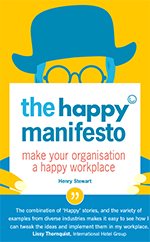How to Change a Demotivated Work Culture
People don’t resist change, they resist being changed. See how Marion Janner’s approach to change in the workplace was too good to resist.
Hi, we are Happy
We are leading a movement to create happy, empowered and productive workplaces.
How can we help you and your people to find joy in at least 80% of your work?

Our image of a hospital mental health ward is not very exciting. Apart from occasional therapy sessions, we might expect to see little activity beyond watching TV, and disengaged staff. Indeed five years ago that is what you might expect to see.
However the picture on UK wards is very different now. One ward organises space hopper races between patients, another has paper plate frisbee. Others have trampolining, exercise machines, indoor cycling or Taekwondo. Dance lessons include hip hop, rock and roll and disco. There have been Elvis and Abba nights. Another held a four-week poetry workshop. In some staff use their own cars to take patients on trips and for family visits. You are likely to find staff absorbed in activity with patients.
A key element in the change has been the work of Star Wards, the organization set up by one inspirational woman, Marion Janner. She decided she wanted to help change the way acute mental health services were delivered in the UK.
However, Marion had no position of power. She didn’t even work in mental health. Her only experience was as a patient, but that gave her lots of ideas how things could be better.
Imagine the normal top-down change program. In the UK the standard government approach is to start by saying how bad things are and how many workers aren’t doing a good enough job. The next step is to prescribe a set of actions, set targets and publish public rankings to name and shame those not doing well enough. And then they wonder why people weren’t eager to take part, and are resistant to change.
Marion did none of that. She started by publishing a booklet of 75 ideas for Improving Patients’ Quality of Time and Treatment Outcomes. These range from staff engaging more with patients to having pets on the ward.
Marion is unrelentingly positive. In five years she has never criticized any provision. Instead, her newsletter praises the good examples she finds, with total respect for the professionals involved. One recent newsletter reported from a ward arranging design competitions and holding space hopper races between patients.
I am lucky enough to be a good friend of Marion and her approach is very definitely based on a philosophy of happy workplaces. “It’s this crazy idea of not telling people what to do,” she explains. “We provided ideas and good examples for ward staff but there was no enforced action. The concept was that if you trusted people and worked to make them feel good, they would come up with great ways of doing things. And, amazingly, it has worked.”
“It’s this crazy idea of not telling people what to do,” she explains. “We provided ideas and good examples for ward staff but there was no enforced action. The concept was that if you trusted people and worked to make them feel good, they would come up with great ways of doing things. And, amazingly, it has worked.”
It has not just worked but brought dramatic transformation. A peer-reviewed study of the effects of Star Wards in just one hospital found it helped reduce average patient stay from 25 days to 20 days, improving patient satisfaction by 83%, reduced violent incidents by 65% and the saving on less use of agency staff alone was $262,000 a year. That is from just one of the 66 hospitals who has implemented the program. All this effect stems from what is still a one-person organization.
Ask yourself how you would create change, if you had no authority whatsoever? What could happen if you based your approach on trusting people and making them feel good, and focused on what was working – not what wasn’t?
Related Blogs
- Creating Happy, Engaged Workplaces in a Traditional Industry - At the 2017 Happy Workplaces Conference Gemma Beadle, the HR Manager at Advanced Technology Services UK, talked about ways to engage, motivate and create a happy workplace.
- How to Build Trust and Credibility in the Workplace - Trust and credibility are essential factors in the creation of a motivated workplace. This blog takes us through some methods for how to go about building up these key elements.
Keep informed about happy workplaces
Sign up to Henry's monthly Happy Manifesto newsletter, full of tips and inspiration to help you to create a happy, engaged workplace.

Learn the 10 core principles to create a happy and productive workplace in Henry Stewart's book, The Happy Manifesto.
Henry's Most Popular Blogs
- 8 Companies That Celebrate Mistakes
- 9 Benefits of Having Happy Employees
- 321Zero: How I Solved my Email Overload
- 16 Companies That Don't Have Managers
- 5 Big Companies Who Swear by Mindfulness
- 49 Steps to a Happy Workplace
- A Four Day Week? Let's Start With a Four Day August
- Google: Hire Great People and Give Them Lots of Autonomy
- Buurtzorg: No Managers, Just Great Care From a Nurse-Led Service
- 30 Steps to Joy at Work: Get More Done by Being Less Busy

Henry Stewart, Founder and Chief Happiness Officer
Henry is founder and Chief Happiness Officer of Happy Ltd, originally set up as Happy Computers in 1987. Inspired by Ricardo Semler’s book Maverick, he has built a company which has won multiple awards for some of the best customer service in the country and being one of the UK’s best places to work.
Henry was listed in the Guru Radar of the Thinkers 50 list of the most influential management thinkers in the world. "He is one of the thinkers who we believe will shape the future of business," explained list compiler Stuart Crainer.
His first book, Relax, was published in 2009. His second book, the Happy Manifesto, was published in 2013 and was short-listed for Business Book of the Year.
You can find Henry on LinkedIn and follow @happyhenry on Twitter.